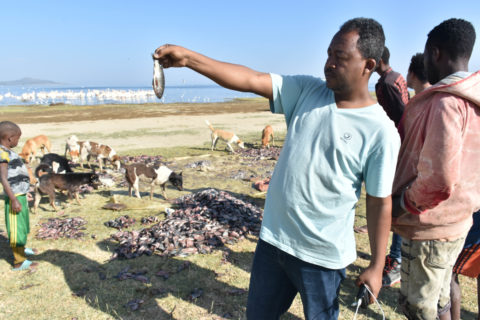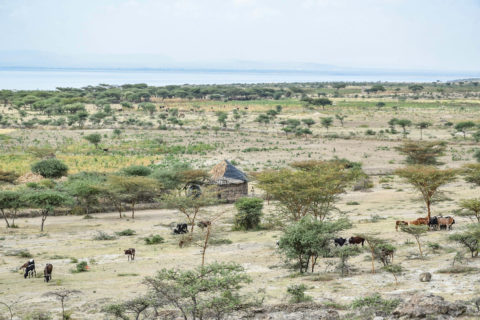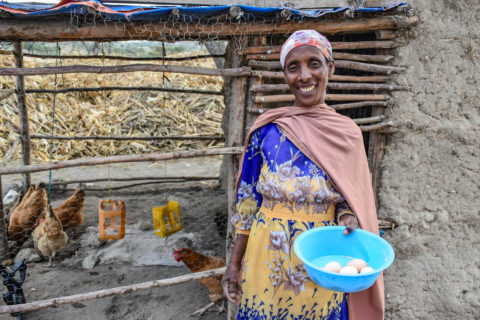Like other areas in the Global South, rapid population growth – among other drivers – in Ethiopia’s Ziway-Shalla Sub-Basin (ZSSB) has exerted tremendous pressure on wetland resources, leading to land clearance for agriculture and overgrazing. This has triggered massive soil erosion, siltation of water bodies, and other forms of degradation.
Degradation of wetland landscapes is particularly severe during dry seasons when local communities are more compelled to cut down trees or burn charcoal for sale to meet their daily needs.

Aschalew Tsegaye, ASLNP Warden shows undersized fish illegally fished from Lake Abijata in the background.
According to Abijata and Shalla Lakes National Park Park Warden, Aschalew Tsegaye, the major threats and challenges to the landscape in the last ten years were increased human settlement and bush clearing for farming, sand mining, overgrazing, overfishing, deforestation for charcoal burning and fuel wood and climate change impacts.
To conserve these wetland landscapes and reduce tree harvesting for fuel wood and charcoal production, Wetlands International is promoting complementary, alternative livelihood options that require low start-up costs and are space-efficient for the communities residing in and around the Abijata and Shalla Lakes National Park (ASLNP) in Ethiopia’s Central Rift Valley.
Soft-spoken Fatuma Dhaabii is a mother who heads her household of five children and several grandchildren. “I got married at 16 years and moved to Galef Kello where I have lived for over 30 years. My husband died 21 years ago. When I moved here, the area had more trees and we could spot lots of wildlife. Lake Abijata had more water and fish than it does today,” she explains.
Fatuma is one of 120 women involved in a pilot community poultry value chain intervention. Supported by Wetlands International and the local government, this intervention aims to strengthen the poultry value chain to enable food-insecure households to improve their nutrition through egg consumption, and sale of eggs and chicken to boost income, thus reducing the need to harvest trees within the landscape.

Over 60,000 farmers and livestock keepers settled in the Park areas, leading to rapid degradation of the wetland landscape
This intervention targets women inhabiting the areas undergoing restoration within and around Abijata and Shalla Lakes National Park. For the pilot project, the recipients were identified through a participatory beneficiary selection process in consultation with the zonal administration and the Park’s officials. In total, 120 poultry beneficiaries, mainly female-led households experienced in traditional chicken rearing, were selected from six villages (kebele) for training on improved poultry management by the Woreda/District Agriculture Poultry Officer. The training included practical demonstrations on chicken coop construction, feeder and drinker setup, and egg-laying nest preparation.
Notably, however, that the cost of acquiring young layers, feeds and chicken coop construction materials (nails, mesh wire, locking rods and plastic sheets for roofing) could hinder these households from engaging in poultry keeping. Wetlands International, therefore, provided construction materials and production inputs while the targeted beneficiaries contributed labour and other construction materials such as building poles.
Lack of awareness by the community, and conflict between the local farmers, livestock keepers and Park officials were a major challenge, according to Aliyi Tumsa of Negelle Woreda Agricultural Office. “The weather conditions in this area are quite harsh, and the community was cutting down trees to survive. Together with the Park officials and Wetlands International, we agreed to conduct numerous awareness meetings with the community for knowledge sharing. That tremendously changed their perceptions of their actions, and the need to work together to bring positive change in the landscape,” he explains.
Eggs and chicken for better income, food security
Five months after the establishment of the poultry project, the farmers began collecting eggs for sale. The poultry products were handled by a series of actors in the intervention area before reaching the end-users, representing a strengthened value chain collaboration with the District Agriculture Office and other stakeholders. The main actors in the value chain include stakeholders who provide technical support such as training, vaccinations market linkage, input suppliers (day-old chicks, pullets, vaccines and concentrate feed) input producers, egg and chicken collectors, small-scale traders, retailers, hotels, resorts and individual consumers.
Before this intervention, the communities in ZSSB typically engaged in backyard poultry rearing, often keeping less than five birds, with each hen producing between 80 to 180 eggs each year. With our intervention, the maximum yield has significantly increased to an optimum 275 eggs per hen per year, demonstrating a huge growth potential in flock size, productivity and household incomes. These households are presently raising a total of 919 chickens, with over half consistently laying eggs.

Fatuma Dhaabii collects eggs from her chicken coop which are then collated by her group for sale at a premium price
“I received 10 chickens from this project. By November 2023, after my group (Hawi Poultry Association) was trained and given chickens, I had sold approximately 400-500 eggs at an average of 8 Birr each. My biggest challenge is, however, the high cost of feeds. I am forced to supplement their feeding with dry maize,” says Fatuma.
This pilot intervention has helped communities to create and diversify economic opportunities which align and complement the Ethiopian Government’s Productive Safety Net Programme (PSNP) to support food-insecure households. In particular, targeting female-led households, mostly widows with low income, the poultry value chain intervention now allows them to earn between 1720-2110 Ethiopian Birr (25 Euro) per month, a plus for social inclusion.
“Today, my family enjoys eating eggs. Whenever I would have visitors in the past, I would fret over what to feed them. Now I serve them eggs with injera,” Fatuma says.
Last December, 60 of the 120 beneficiaries also received solar panels on a cost-share basis and are engaged in other value chains like goat fattening and crop cultivation to increase household incomes.
This intervention has elevated Fatuma’s hopes and dreams. “From the income earned from selling eggs, I have bought a goat and can now pay school fees for my children and afford groceries, unlike before. I save my money through our traditional method called ekut. My dream is to increase my flock in addition to engaging in cattle-fattening value chain.”
According to Dr Abdullaah Beekaa Aliyyii who heads the Agriculture Office in the West Arsi Zone of Oromia State, food prices in this area are high, and malnutrition is common. “The communities here need alternative economic gains to reduce dependence on extraction of natural resources. These can be achieved through capacity building, providing capital for start-ups, and regular support from government agencies, partners and other stakeholders. There is room for additional alternative activities and expansion to other villages,” he explains.
Key lessons
There are four key lessons learned from this value chain intervention. Firstly, social inclusion in such interventions should be considered during the design phase. Female-led households which more often than not have comparatively lower incomes are more dependent on natural resources for income and wood fuel, and are considerably more vulnerable to climate shocks. Their inclusion in livelihood projects improves family nutrition and health, boosts household incomes, and reduces their households’ dependence on wetlands resources.
Secondly, stakeholders and donors should consider fortifying subsistence systems through capacity building, funding and strengthening of value chains to improve production, enable access to markets and raise household incomes that benefit both the local communities and wetland landscapes.
Thirdly, close collaboration by different actors in the value chain within a landscape is critical. Everyone across the value chain – from farm input suppliers to transporters and poultry farmers – earns more as a result of increased productivity. Such collaboration may also expose the local communities to multiple initiatives that boost their income and lives further.
Finally, the compelling need to embrace integrated wetlands landscape management cannot be gainsaid. Natural landscapes including protected areas do not exist in isolation. Local communities who live adjacent to wetland landscapes are the direct guardians. There is, therefore, a need to collaborate with them and all key stakeholders to conserve and restore degraded areas such as those within Ethiopia’s Ziway-Shalla Sub-Basin.
This blog is adapted from a case study developed by Abinet Wogayehu on the Source to Sea Wetlands Eastern Africa Wetland Initiative
Lead image: Lake Abijata’s birdlife showing signs of recovery with the ongoing restoration of the wetland landscape

